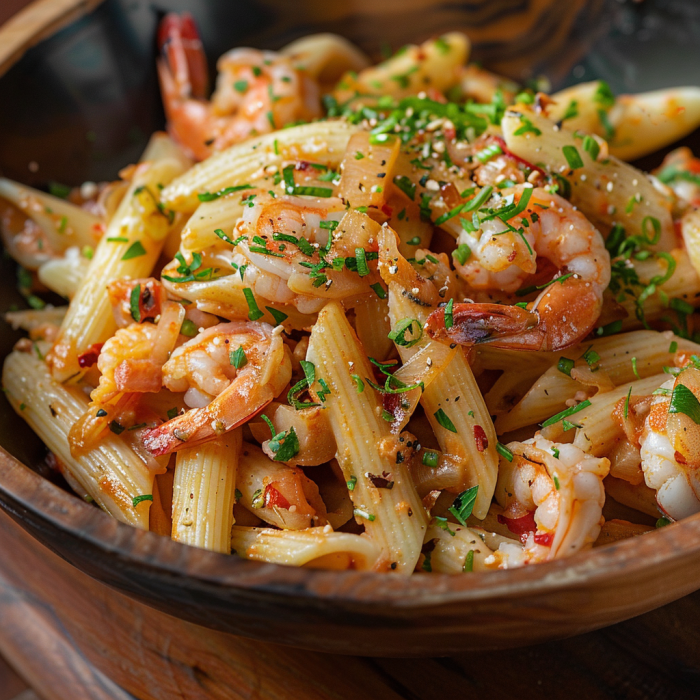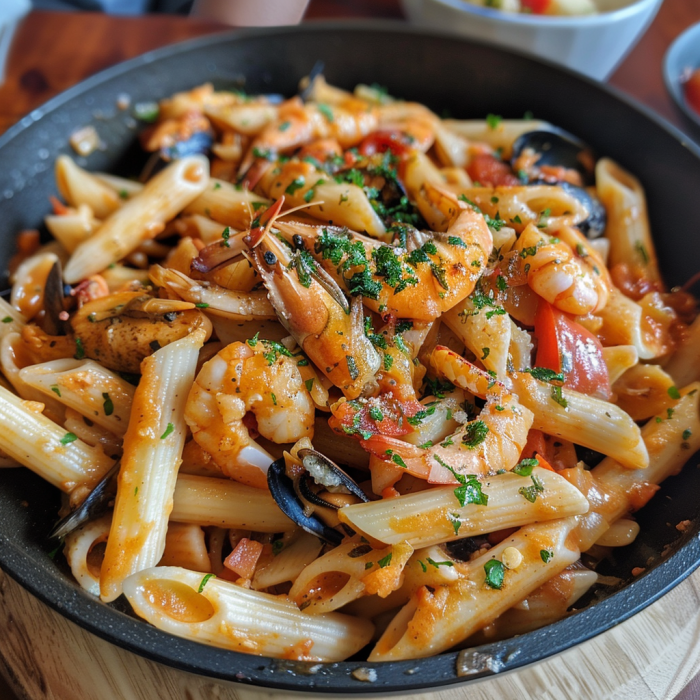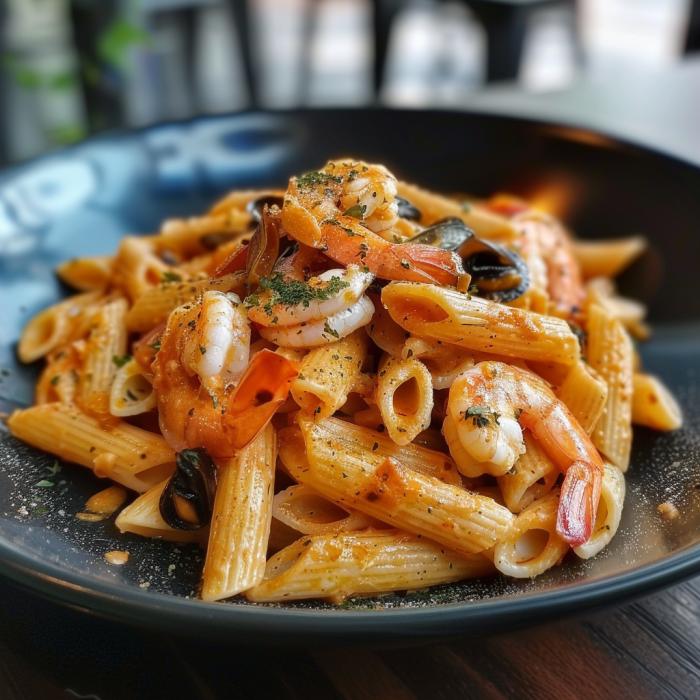Introduction
Penne, one of the most beloved types of pasta, is a staple in many households. It’s versatile, easy to cook, and can be paired with an array of sauces and ingredients. Whether you’re a pasta aficionado or just looking for a quick weeknight meal, penne can be your go-to. In this article, we’ll delve into the history of penne, explore different types, share cooking tips, and present delicious recipes that are sure to become family favorites. Additionally, we’ll touch on the nutritional benefits of penne and answer some common questions to help you make the most out of this classic pasta.
Introduction to Penne
Introduction to Penne Pasta
Penne pasta, a popular variety of pasta shaped like small tubes, is well-loved for its ability to hold sauces and deliver a satisfying bite. Its name, derived from the Italian word for quill or pen, reflects its unique cylindrical shape with angled ends, reminiscent of a quill pen. This pasta type is incredibly versatile and pairs well with both chunky and smooth sauces, making it a favorite in numerous recipes.
Historical Background
The origins of penne can be traced back to the Campania region of Italy. This type of pasta became popular in the mid-19th century when a pasta maker named Giovanni Battista Capurro patented a machine that could cut the pasta diagonally, mimicking the quill of a pen. This innovation allowed for the creation of penne lisce (smooth penne) and penne rigate (ridged penne), providing options that cater to different sauce preferences. Throughout the years, penne has cemented its place in Italian cuisine and spread across the globe, becoming a pantry staple in many households.
Penne pasta is not just about tradition; it’s also about adaptability. It can be dressed up for a gourmet meal or kept simple for a quick dinner, offering endless possibilities in the kitchen. From classic Italian recipes to innovative new dishes, penne remains a favorite choice for pasta lovers everywhere.

Cooking Penne
Cooking Techniques
Cooking penne pasta to perfection is both an art and a science. Here, we’ll cover the essential techniques to ensure your penne turns out just right every time.
Boiling Penne Perfectly
Cooking penne pasta to perfection is both an art and a science. Therefore, here, we’ll cover the essential techniques to ensure your penne turns out just right every time.
Cook the penne according to the package instructions, typically around 10-12 minutes for al dente. Taste a piece a minute or two before the suggested time to check for your desired firmness. Once the penne is cooked, reserve a cup of the pasta water (it can be great for adjusting sauce consistency later) and then drain the pasta.
Al Dente vs. Well-Cooked
The term “al dente” translates to “to the tooth,” describing pasta that’s cooked to be firm to the bite. Al dente penne is ideal for dishes that will be baked or simmered further with a sauce, as it holds its shape better and offers a pleasant texture. If you prefer a softer texture, you can cook the penne a minute or two longer, but be cautious not to overcook it, as it can become mushy and lose its appeal.
Penne Cooking Tips and Tricks
Here are a few additional tips to ensure your penne is always perfect:
- Stirring: Stir the penne occasionally while it’s boiling to prevent clumping.
- Timing: Be vigilant with the cooking time. Overcooked pasta can ruin a dish.
- Sauce Integration: If you’re making a sauce, add the cooked penne directly into the sauce pan and toss it together over medium heat for a minute. This helps the pasta absorb the flavors and ensures every bite is delicious.
With these techniques and tips, you’ll master the art of cooking penne. In the next section, we’ll explore some classic penne recipes that showcase this pasta’s versatility.
Classic Penne Recipes
Classic Penne Recipes
Penne pasta shines in a variety of traditional Italian dishes. Let’s explore some timeless recipes that highlight the versatility and deliciousness of penne.
Ingredients:
- Penne pasta
- Tomato sauce
- Heavy cream
- Red pepper flakes
- Parmesan cheese
Steps:
- Cook penne until al dente.
- In a large pan, heat tomato sauce and add a pinch of red pepper flakes.
- Stir in heavy cream and let it simmer until the sauce thickens.
- Add the cooked penne to the sauce and toss to coat.
- Serve hot, garnished with grated Parmesan cheese.
Penne Arrabbiata
For those who love a bit of spice, Penne Arrabbiata is the perfect choice. “Arrabbiata” means “angry” in Italian, referring to the fiery kick of this tomato-based sauce.
Ingredients:
- Penne pasta
- Olive oil
- Garlic
- Crushed red pepper
- Tomatoes
- Fresh parsley
Steps:
- Cook penne according to package directions.
- In a skillet, heat olive oil and sauté garlic until golden.
- Add crushed red pepper and tomatoes, simmering until the sauce thickens.
- Toss the penne in the sauce and sprinkle with fresh parsley before serving.

Penne with Tomato Sauce
A timeless dish, Penne with Tomato Sauce is simple yet incredibly satisfying. This recipe highlights the natural sweetness of tomatoes and the subtle flavors of garlic and basil.
Ingredients:
- Penne pasta
- Olive oil
- Garlic
- Tomatoes
- Fresh basil
Steps:
- Boil penne until al dente.
- In a pan, heat olive oil and sauté garlic.
- Add chopped tomatoes and cook until they break down into a sauce.
- Stir in fresh basil and combine with the cooked penne.
Penne with Meat Sauce
A hearty option, Penne with Meat Sauce combines the rich flavors of ground meat with a savory tomato sauce. It’s a meal that’s sure to please everyone at the table.
Ingredients:
- Penne pasta
- Ground beef or turkey
- Onion
- Garlic
- Tomato sauce
- Italian seasoning
Steps:
- Cook penne and set aside.
- In a skillet, cook ground meat until browned.
- Add chopped onion and garlic, sautéing until tender.
- Stir in tomato sauce and Italian seasoning, letting it simmer.
- Mix the cooked penne with the meat sauce and serve hot.
For an authentic recipe and more details, check out this penne with meat sauce recipe.
Penne Alfredo
Penne Alfredo is a creamy, decadent dish that pairs perfectly with the tender texture of penne pasta. The combination of butter, cream, and Parmesan cheese creates a sauce that’s indulgent and delicious.
Ingredients:
- Penne pasta
- Butter
- Heavy cream
- Parmesan cheese
- Garlic
Steps:
- Boil penne until al dente.
- In a saucepan, melt butter and add heavy cream.
- Stir in Parmesan cheese and garlic, cooking until the sauce thickens.
- Toss the cooked penne in the Alfredo sauce and serve immediately.
These classic recipes showcase the versatility of penne pasta and are sure to become favorites in your household. For more information on crafting a delicious Alfredo sauce, check out this comprehensive guide. Next, we’ll explore some creative penne dishes that offer a twist on traditional flavors.
Creative Penne Dishes
Innovative Recipes
Penne pasta isn’t just for traditional dishes. Here are some innovative recipes that bring a modern twist to this classic pasta.
Baked Penne Casserole
Baked penne casserole is a comforting dish that’s perfect for feeding a crowd. Combining layers of penne, sauce, and cheese, it’s a guaranteed hit.
Ingredients:
- Penne pasta
- Tomato sauce
- Mozzarella cheese
- Ground beef or sausage
- Italian seasoning
Steps:
- Cook penne until al dente.
- In a large baking dish, layer penne with tomato sauce, cooked meat, and mozzarella cheese.
- Sprinkle with Italian seasoning and bake until the cheese is melted and bubbly.
Penne with Pesto
Penne with pesto is a fresh and flavorful dish that’s quick to prepare. The bright green pesto sauce made from basil, garlic, pine nuts, and Parmesan cheese pairs beautifully with penne pasta.
Ingredients:
- Penne pasta
- Fresh basil
- Garlic
- Pine nuts
- Parmesan cheese
- Olive oil
Steps:
- Cook penne and set aside.
- In a food processor, blend basil, garlic, pine nuts, and Parmesan cheese.
- Slowly add olive oil until the mixture becomes a smooth pesto sauce.
- Toss the penne with the pesto sauce and serve.

Penne Primavera
Penne Primavera is a vibrant dish loaded with fresh vegetables. It’s a great way to incorporate more veggies into your diet while enjoying a delicious pasta meal.
Ingredients:
- Penne pasta
- Bell peppers
- Zucchini
- Cherry tomatoes
- Garlic
- Olive oil
Steps:
- Boil penne and set aside.
- In a large skillet, sauté chopped vegetables and garlic in olive oil.
- Add cooked penne to the skillet and toss to combine.
- Season with salt and pepper to taste.
Penne with Seafood
For a luxurious twist, try penne with seafood. Combining penne with shrimp, scallops, or your favorite seafood in a light sauce creates an elegant and satisfying meal.
Ingredients:
- Penne pasta
- Shrimp or scallops
- Garlic
- Olive oil
- Fresh herbs
Steps:
- Cook penne until al dente.
- In a skillet, sauté seafood with garlic and olive oil.
- Toss the seafood with the cooked penne and garnish with fresh herbs.
Nutritional Information and Health Benefits
Nutritional Profile of Penne
Penne pasta, like many other types of pasta, is primarily made from durum wheat semolina. It offers a good balance of carbohydrates, proteins, and some essential nutrients. Understanding its nutritional profile can help you incorporate it into a balanced diet.
- Carbohydrates: Penne is a great source of complex carbohydrates, providing energy to fuel your day. One cup of cooked penne contains approximately 43 grams of carbs.
- Protein: Penne also contains a moderate amount of protein, about 7 grams per cup, which is essential for muscle repair and growth.
- Fiber: Whole wheat penne offers higher fiber content, aiding in digestion and providing a feeling of fullness. A cup of whole wheat penne contains around 6 grams of fiber.
- Vitamins and Minerals: Penne is a source of B vitamins (like folate and thiamin) and minerals such as iron and magnesium, which play vital roles in energy metabolism and overall health.
Health Benefits of Penne
Incorporating penne into your diet can offer several health benefits, especially when combined with nutritious ingredients and balanced portions.
Energy Boost
Due to its high carbohydrate content, penne provides a significant energy boost. This makes it an excellent choice for active individuals and athletes who need sustained energy levels for their activities.
Digestive Health
Whole wheat penne, in particular, is beneficial for digestive health. The high fiber content aids in regular bowel movements, prevents constipation, and promotes a healthy gut. Moreover, fiber can help manage blood sugar levels by slowing down the absorption of sugar into the bloodstream.
Weight Management
When consumed in moderation, penne can be part of a weight management plan. The complex carbs and fiber in whole wheat penne help you feel full longer, reducing the likelihood of overeating. Pairing penne with vegetables, lean proteins, and healthy fats can create a well-rounded, satisfying meal.
Heart Health
Penne made from whole grains may contribute to heart health. Whole grains have been shown to lower the risk of heart disease by improving cholesterol levels and reducing inflammation. Including whole wheat penne in a balanced diet can support cardiovascular health.
By understanding the nutritional profile and health benefits of penne, you can make informed choices about incorporating this versatile pasta into your diet. Next, we’ll explore serving suggestions and complementary dishes that pair well with penne.
Serving Suggestions and Pairings
Complementary Dishes
Pairing penne pasta with the right dishes can elevate your meal, creating a balanced and flavorful dining experience. Here are some suggestions to complement your penne dishes perfectly.
Best Sauces for Penne
The beauty of penne lies in its adaptability to various sauces. Here are some classic and innovative sauces that pair exceptionally well with penne:
- Marinara Sauce: A simple yet flavorful tomato-based sauce that’s a staple in many Italian dishes.
- Pesto Sauce: Made from fresh basil, garlic, pine nuts, Parmesan cheese, and olive oil, pesto adds a burst of flavor to penne.
- Creamy Alfredo: A rich and creamy sauce made from butter, heavy cream, and Parmesan cheese, perfect for a decadent meal.
- Arrabbiata Sauce: A spicy tomato sauce with garlic and red pepper flakes, ideal for those who enjoy a bit of heat.
Side Dishes and Appetizers
Enhance your penne dishes with these delightful side dishes and appetizers:
- Garlic Bread: Crunchy on the outside and soft on the inside, garlic bread is a classic companion to any pasta dish.
- Caesar Salad: Crisp romaine lettuce, creamy dressing, and Parmesan cheese make for a refreshing and complementary salad.
- Caprese Salad: Fresh tomatoes, mozzarella cheese, and basil drizzled with balsamic glaze offer a light and flavorful appetizer.
Non-Alcoholic Beverage Pairings
Pairing your penne dishes with the right non-alcoholic beverages can enhance the overall dining experience:
- Sparkling Water with Lemon: The crisp and refreshing taste of sparkling water with a hint of lemon cleanses the palate between bites.
- Herbal Iced Tea: A light and flavorful option that pairs well with both creamy and tomato-based penne dishes.
- Fresh Fruit Juice: Juices like apple or grape provide a sweet contrast to savory pasta dishes.
These serving suggestions and pairings can transform your penne meals into memorable dining experiences. Next, we’ll address some frequently asked questions about penne to provide you with more insights and tips.
Frequently Asked Questions (FAQs)
FAQs
How to Store Cooked Penne?
To store cooked penne, first ensure it’s cooled to room temperature. Place it in an airtight container and refrigerate. It can last for up to 3-5 days. Adding a bit of olive oil before sealing can prevent the pasta from sticking together.
Can Penne be Frozen?
Yes, penne can be frozen. Spread the cooked penne on a baking sheet to freeze individually before transferring to a freezer bag or container. This method prevents clumping and makes reheating easier. Frozen penne can be stored for up to three months.
What is the Origin of Penne Pasta?
Penne pasta originated in Italy, specifically in the Campania region. The name “penne” comes from the Italian word for “quill,” referencing the pasta’s cylindrical shape with angled ends.
How to Reheat Penne Pasta?
To reheat penne, you can use the microwave or stovetop. For the microwave, sprinkle a bit of water over the pasta and cover it before heating. On the stovetop, reheat penne in a pan with a splash of water or sauce to prevent drying out. Stir occasionally until heated through.
These FAQs provide practical tips and interesting facts about penne pasta. Next, we’ll wrap up the article with a summary of key points and final thoughts on penne.
Conclusion
Wrapping Up
Penne pasta, with its rich history and versatility, remains a favorite in kitchens around the world. From classic recipes like Penne Arrabbiata to innovative dishes like baked penne casserole and penne with pesto, there’s a dish for every palate. Understanding the different types and cooking techniques ensures your penne is always perfect. Plus, recognizing its nutritional benefits helps you make healthier choices.
Final Thoughts on Penne
Whether you’re cooking for a weeknight dinner or preparing a special meal, penne pasta is a reliable and delicious option. Its ability to adapt to various sauces and ingredients makes it a valuable staple in any kitchen. Embrace the versatility of penne and explore the endless culinary possibilities it offers.

